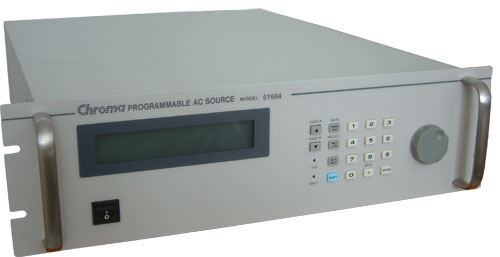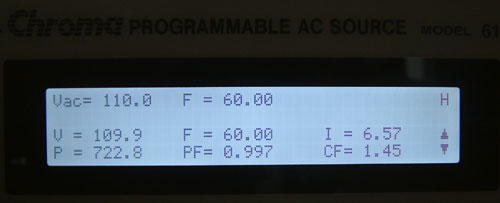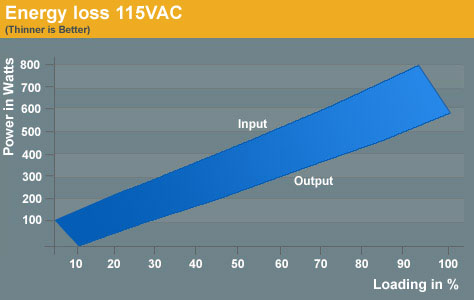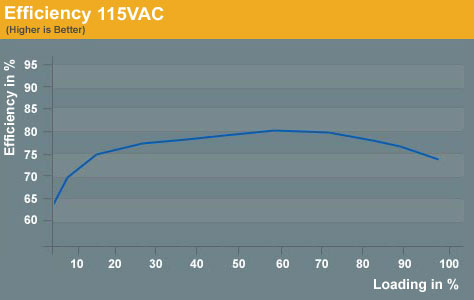AnandTech Power Supply Test Methodology
by Christoph Katzer on July 12, 2007 12:00 AM EST- Posted in
- Cases/Cooling/PSUs
Chroma Programmable AC Source 61604

In most parts of the world it is usual to use a grid power of 230VAC with a frequency of 50Hz. In the US, Canada, and parts of South America however the standards are around 117VAC with a frequency of 60Hz (commonly rounded to 120VAC). To provide our readers the maximum range the units can handle, we are testing power supplies with multiple inputs in these different voltage ranges.
The difference in the DC output between 110VAC and 120VAC is marginal, but from 120VAC to 230VAC it's another story. Lower input voltage results in a higher energy usage by the power supply, and higher power usage lowers the efficiency of each power supply. Therefore we will see differences between tests at 115VAC and those at 230VAC. By covering these two different input voltages of 115VAC and 230VAC we will offer a good variety for all our readers and we will provide the only current public tests conducted at both input voltages.
The Chroma model 61604 is capable of providing 0 - 300VAC with a power up to 2000 volt-amperes (VA). The output frequency can be selected between 15Hz and 1000Hz. To simulate a perfect environment we use 50Hz for the test with 230VAC and 60Hz for 115VAC, which is what users generally find at the power grid in various countries.
However, our AC Source actually provides two functions. The first is that it acts as a normal AC Source, allowing us to test with different voltages. Second, it is also a power meter that gives us important data like power usage and power factor.

The display shows us several important numbers. The top row contains information regarding the power that we want the device to deliver. The two lower rows display the actual delivered voltage, power consumption from the power grid, frequency, power factor, current and the crest factor. For our tests the most important items are the voltage, frequency, power consumption and power factor. In our reviews we will include a graph which will show the energy loss from the power supply during testing as follows.

Sample Energy Loss
The upper line marked with Input is the actual power drawn from the power grid. The line below marked with Output is the DC power which is given to the PC. Usually at lower power draws from the system the power loss will be lower as well. This can be seen by the increasing distance between the two lines, which grows steadily with increasing power usage.
By loading a power supply at a specific level, we get both the power input and the power output. Dividing these two units gives the efficiency of each tested power supply. Efficiency has become a modern benchmark for power supplies and many companies build their complete marketing strategy on high efficiency. To make this efficiency readable we will use a graph which shows each step at a specific point of load. To get the best overall impression of a power supply we decided to test in steps of 10% of the actual load each power supply is able to deliver. The load of each rail is calculated in conformity with the Power Supply Design Guide V1.1 released by Intel in March of this year.

Sample Efficiency
The efficiency is normally displayed in a curve which starts at a low point around 60 to 70%. With increasing loads the curve will usually reach its zenith at 50% to 70% of the maximum load the power supply can handle. This means that at this point the power supply has its best efficiency and ideally it should spend most of its time running in this area. High loads push the power supply beyond this point to where the curve is normally heading down again.
The important thing to take away from this is that it's not easy to buy a perfect power supply for the home PC and a little bit of calculation needs to be done. Remember that the power supply should not run at lower or higher loads most of the time. The former happens when a user buys a power supply that provides more potential power than they need, while the latter occurs when users purchase power supplies that meet their minimum requirements. This is information that many marketing departments aren't interested in disseminating, however, and some companies are advertising power supplies rated at more than 1000W - something which few if any PCs will need at the moment.

In most parts of the world it is usual to use a grid power of 230VAC with a frequency of 50Hz. In the US, Canada, and parts of South America however the standards are around 117VAC with a frequency of 60Hz (commonly rounded to 120VAC). To provide our readers the maximum range the units can handle, we are testing power supplies with multiple inputs in these different voltage ranges.
The difference in the DC output between 110VAC and 120VAC is marginal, but from 120VAC to 230VAC it's another story. Lower input voltage results in a higher energy usage by the power supply, and higher power usage lowers the efficiency of each power supply. Therefore we will see differences between tests at 115VAC and those at 230VAC. By covering these two different input voltages of 115VAC and 230VAC we will offer a good variety for all our readers and we will provide the only current public tests conducted at both input voltages.
The Chroma model 61604 is capable of providing 0 - 300VAC with a power up to 2000 volt-amperes (VA). The output frequency can be selected between 15Hz and 1000Hz. To simulate a perfect environment we use 50Hz for the test with 230VAC and 60Hz for 115VAC, which is what users generally find at the power grid in various countries.
However, our AC Source actually provides two functions. The first is that it acts as a normal AC Source, allowing us to test with different voltages. Second, it is also a power meter that gives us important data like power usage and power factor.

The display shows us several important numbers. The top row contains information regarding the power that we want the device to deliver. The two lower rows display the actual delivered voltage, power consumption from the power grid, frequency, power factor, current and the crest factor. For our tests the most important items are the voltage, frequency, power consumption and power factor. In our reviews we will include a graph which will show the energy loss from the power supply during testing as follows.

Sample Energy Loss
The upper line marked with Input is the actual power drawn from the power grid. The line below marked with Output is the DC power which is given to the PC. Usually at lower power draws from the system the power loss will be lower as well. This can be seen by the increasing distance between the two lines, which grows steadily with increasing power usage.
By loading a power supply at a specific level, we get both the power input and the power output. Dividing these two units gives the efficiency of each tested power supply. Efficiency has become a modern benchmark for power supplies and many companies build their complete marketing strategy on high efficiency. To make this efficiency readable we will use a graph which shows each step at a specific point of load. To get the best overall impression of a power supply we decided to test in steps of 10% of the actual load each power supply is able to deliver. The load of each rail is calculated in conformity with the Power Supply Design Guide V1.1 released by Intel in March of this year.

Sample Efficiency
The efficiency is normally displayed in a curve which starts at a low point around 60 to 70%. With increasing loads the curve will usually reach its zenith at 50% to 70% of the maximum load the power supply can handle. This means that at this point the power supply has its best efficiency and ideally it should spend most of its time running in this area. High loads push the power supply beyond this point to where the curve is normally heading down again.
The important thing to take away from this is that it's not easy to buy a perfect power supply for the home PC and a little bit of calculation needs to be done. Remember that the power supply should not run at lower or higher loads most of the time. The former happens when a user buys a power supply that provides more potential power than they need, while the latter occurs when users purchase power supplies that meet their minimum requirements. This is information that many marketing departments aren't interested in disseminating, however, and some companies are advertising power supplies rated at more than 1000W - something which few if any PCs will need at the moment.










49 Comments
View All Comments
jtleon - Thursday, July 12, 2007 - link
For the most accurate sound level testing, the air temperature around the microphone and the power supply is very VERY important. The microphone must reach steady state temperature and be calibrated at that temperature. The air temperature in the anechoic chamber must be maintained as constant, otherwise the microphone measurements will be off as much as 3-4dB in my experience for a temp delta of only 15°F.Also, no one is interested in the noise PS generates inside the PC case, rather the noise emitted to the exterior of the PC. And beware the air temperature inside the PC is much much higher than the interior PC air temperature. I don't see how your test approach will address these critical issues.
jtleon - Thursday, July 12, 2007 - link
Ooops...I meant to say,And beware the air temperature inside the PC is much much higher than the exterior PC air temperature.
LTG - Thursday, July 12, 2007 - link
This is exactly the high bar I expected from AT and I'm really glad to see you guys do it right.I've always felt that other review sites were missing a lot in this area.
LTG
lsman - Thursday, July 12, 2007 - link
Thanks, looking forward for the reviews. Please don't let it delay (or MIA) like those m-atx or motherboard.It will be more interesting than all those HSF reviews...
Kensei - Thursday, July 12, 2007 - link
A small nitpick... Japan is also 120VAC (actually 100) and uses flat blade plugs. I live in Japan and everthing I brought here from the US works fine. See
http://www.kropla.com/electric2.htm
Martimus - Thursday, July 12, 2007 - link
I used to test power sources and signal sources for variaous automotive components, and I am wondering why you are using a multimeter to measure the output instead of an oscilliscope. You can measure both current and voltage and actually capture the waveform to measure the ripple voltage with a good o-scope. When it comes to analyzing signals, the oscilliscope is a far more valuable tool than a multimeter.just my 2 cents.
acronos - Thursday, July 12, 2007 - link
I'm interested in how the power supply handles electrical noise from the power company. I know most of us have battery backups, but the power supply should do power line noise suppression too. In my area we have brownouts (low voltage), spikes (lightning strikes nearby), and just general noise. I also use computers in a manufacturing environment, which causes significant noise on the power lines.LoneWolf15 - Thursday, July 12, 2007 - link
What you want then, are line conditioners, or a UPS with line-conditioning capability.The most a power supply provides is Active Power Factor Correction, which will clean up things a little, but that's not a subsitute for a UPS with line conditioning, which will solve your issues with brownouts and spikes. This kind of gear would be expensive and bulky to try and add into a power supply; I don't see it happening any time soon.
LoneWolf15 - Thursday, July 12, 2007 - link
Clarification: Not every PSU has Active PFC --a better explanation can be found here:http://www.dansdata.com/gz028.htm">http://www.dansdata.com/gz028.htm
sprockkets - Saturday, July 14, 2007 - link
Yeah very good explanation. Another way of looking at it is I found a site sometime ago that showed the pfc as a 90 triangle to show the relationship.I'm looking for a good test of those fanless power supplies, but again, without a fan it does put a damper in the cooling.